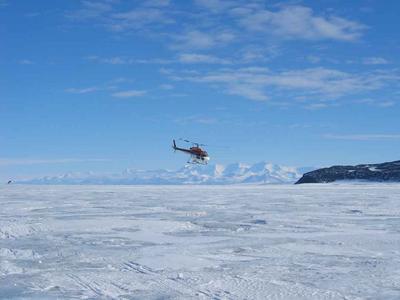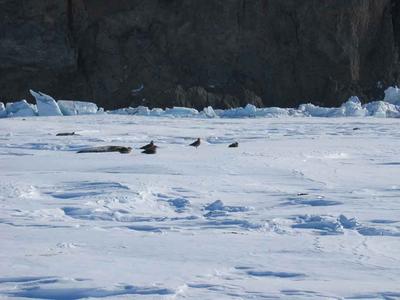4 November, 2003
We will be doing our first population census on Friday. In
preparation for this census, Gillian, Kelly, and Brent went on a
helicopter flight over the study area this afternoon to see whether
there were any groups of seals outside the established colonies that
we would need to check. It was a beautiful day for flying, with
clear skies and calm winds once again. Rumor has it that these
stellar weather conditions are due to change in the near future. I
suppose that 12 days of mostly clear and relatively windless weather
is all one can ask for here.
Mark and I returned to Turks Head to finish the tagging he and
Gillian had begun yesterday. On Monday they had tagged 21 new pups
and adults, but ran out of time and energy before finishing the
entire colony. There were 14 new pups there today to tag. This is
one of the larger colonies within our study area.
As the number of live seal pups has increased, so has the number of
dead seal pups. Some appear to have been abandoned by their
mothers-we often see these pups alone within the colony for a few
days before they die of starvation. Others have died from
environmental causes-we saw one pup frozen into a meltwater pool atop
the ice. We have also seen pups that, apparently, died at birth and
were still encased in their placentas. Although these seals live in a
world without terrestrial predators, it is obvious that other factors
can affect pup mortality.
One animal, the Skua, is never far from these seal colonies during
the pupping season. These birds are the scavengers of coastal
Antarctica, and must work quickly to feed on the dead pups since
everything freezes within hours. Once the carcasses are frozen, they
may last for years, disappearing only when the ice around them melts
and they are released into the ocean below.
Daily Haiku:
Clear skies once again
Weather changes predicted
Low pressure coming

Taking off for an aerial survey of the study area.

The birds in this photograph are Skuas.
Contact the TEA in the field at
.
If you cannot connect through your browser, copy the
TEA's e-mail address in the "To:" line of
your favorite e-mail package.
|
